We love aloe plants due to their large and fleshy leaves folded into a dense rosette to bring a decorative appeal. These succulents can be grown indoors and outdoors to mark a bold statement in your home.
Aloe plants have medicinal properties and are readily available. But there are over 300 species of aloe with unique properties and decorative appeal. Some succulents have a similar appearance to aloe due to their dense rosette of fleshy leaves.
Examples of plants that look like aloe vera are agave, hechtia, gasteria, haworthia, bergeranthus, Ariocarpus, and faucaria. These succulents have a rosette of large and fleshy leaves.
Aloe vera plants are closely related to these succulents though they have different names. We wrote this article to provide detailed insights about indoor plants that look like aloe vera.
You May Also Like: 20 Plants with Black Flowers for Your Garden
What Does Aloe Vera Plant Look Like?
Aloe vera is a succulent plant that belongs to the Aloe genus. The succulent species are short-stemmed with large, greenish, and fleshy leaves folded into a dense rosette that looks like a fan.
Identifying an aloe vera plant is simple due to its distinct appearance compared to other Aloe genus members. (Source: North Carolina State University). Below are the features that describe what aloe vera plants look like:
The Leaves
Aloe vera plants have thick, green, and fleshy leaves that grow in a circle. Juvenile leaves form a new circle in the middle and spread outwards.
The rosette form gives the aloe plant the look of an upside-down umbrella. The edges of each leaf have short and sharp thorns similar to a cactus.
The Flowers
Mature aloe vera plants produce a trumpet-like bloom at the top of a stem. The flowers can be red, yellow, orange, or white and resemble wheat due to their angle at the end of the stem.
The Stems
Aloe vera plants are stemless or very short-stemmed. Due to the folding of the leaves, the sheaths give the plant an upright posture. The aloe plant grows to a height of two feet.
Succulent Plants that Look like Aloe Vera
There are several non-poisonous and poisonous plants that look like aloe vera. Some have leaves similar to aloe vera, and others have spiky foliages. Below is a list of large plants that look like aloe vera:
Agave Plant
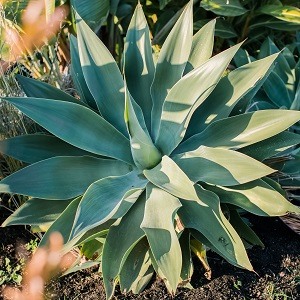
Agave plants are stemless perennial succulents native to Mexico and North and Central America. They have large and fleshy leaves that fold to form a dense root rosette.
The agave leaves have sharp points with straight or bent spines on their edges. The leaves can be green, gray, or blue-green. Some leaves have yellow or silvery-white stripes that look like threads.
The leaf plate has rich waxy patina coats to protect the plant from cold or heat. Agave plants have fibrous roots that bind them to rocks or trees to enhance upright growth above the ground level.
| Origin | Mexico and arid regions of America |
| Appearance | Grow in rosette shape with succulent leaves |
| Leaf Margin | Have spines |
| Flowers Color | Yellow bloom in summer |
| Maximum Height | 1-20ft tall |
Dyckia and Hechtia
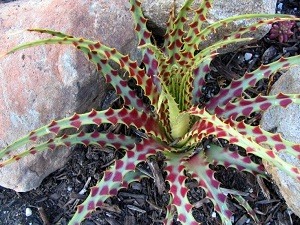
The succulent is also called dryland bromeliad. It is closely related to pineapples and has numerous benefits for human beings. Hechtia are native to Southwestern America and Mexico, with over 100 species.
Dyckia are native to South America (Brazil) and thrive in well-drained soil. Dyckia have leaves with sharp spines that make them difficult to handle. They are also drought tolerant and require low maintenance.
Bromeliads come in different colors and sizes. They also produce offsets that can be removed to create new plants. They are suitable as groundcovers, containers, and accent plants for landscaping.
| Origin | Mexico and Brazil |
| Appearance | Leaves grow at the bottom to form a rosette. |
| Leaf Margin | Sharp spines |
| Flowers Color | White or Pink bloom in spring |
| Maximum Height | 2-3ft tall. |
Bergeranthus
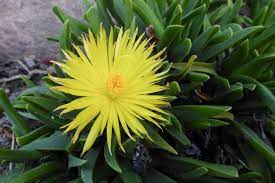
Bergeranthus is a member of the Aizoaceae family and hails from South Africa. The succulent has thick and fleshy leaves that store water to enhance survival in semi-arid regions.
These greenery plants can tolerate drought and add a masterpiece statement to your home. The foliages have medicinal properties ideal for healing wounds and sunburns for centuries.
Multiceps bergeranthus has a rosette-like appearance with 2-3inches of leaves. The leaves also have a long trihedral prism with pointed ends. The bergeranthus species bear yellow solitary flowers.
Bergeranthus scapiger has deep green leaves with a broad base and tapered ends. The leaves have serrated margins and produce an orange-yellow bloom.
| Origin | South Africa |
| Appearance | Green with succulent leaves |
| Leaf Margin | Serrated with short spines |
| Flowers Color | Orange-yellow bloom |
| Maximum Height | 3-5 inches |
Ariocarpus
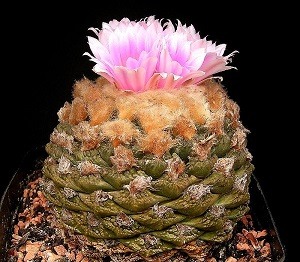
It is a small slow-growing succulent that looks like miniature cacti. Ariocarpus is also called living rock due to its unusual looks. The succulent is closely related to peyote and other mescaline-containing cacti.
Ariocarpus is ideal for indoor and outdoor gardens. These succulents hail from Mexico and Texas desert. They are drought tolerant and can survive for an extended period without water.
These succulents store water in the stems and leaves. These features make them an ideal choice for landscaping with drought-tolerant plants. Their slow-growing nature makes them require low maintenance.
| Origin | Mexico and Texas |
| Appearance | Small with fleshy stems and leaves |
| Leaf Margin | Smooth |
| Flowers Color | No flowers |
| Maximum Height | 4-25cm |
Faucaria

It is a leaf-succulent plant that hails from Southern Africa. The majority of the species are native to Cape Province and Namibia. Tiger’s jaw or cat’s mouth is the best-known faucaria species.
These succulents have fleshy and triangular leaves with serrated margins. Faucaria feline is an ornamental succulent since it produces orange-yellow flowers in the winter.
The succulent species have medicinal properties for treating stomach problems, diarrhea, and dysentery. The leaves have anti-inflammatory properties to poultice wounds and bites.
| Origin | South Africa and Namibia |
| Appearance | Fleshy triangular leaves that grow in pairs. |
| Leaf Margin | Serrated margins |
| Flowers Color | Orange-yellow bloom |
| Maximum Height | 6-inches |
Haworthia
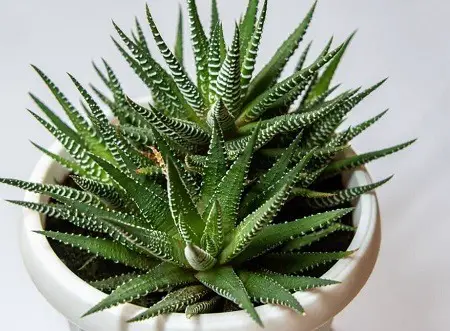
Haworthia succulents are native to South African steppes and deserts. There are over 150 species of Haworthia with different leaf appearances and colors. Some species have blunt and fleshy leaves with yellow-slivery stripes and spines.
The plant has rosette-shaped leaves of 11-inches long. The leaves grow in dense mass making them look like miniature agave or aloe vera plants. Indoor haworthia plants do not bloom.
| Origin | South Africa |
| Appearance | Green leaves with white spots |
| Leaf Margin | Serrated margins |
| Flowers Color | No flowers |
| Maximum Height | 3-5 inches |
Gasteria
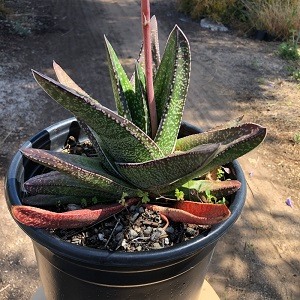
This southern African desert succulent belongs to the Asphodelaceae family. The succulent has small and short leaves with fleshy margins.
Gasteria has a deep shade of dark green foliages covered with brown or silver streaks. Some species have leaves covered with white spots, hence the plant that looks like aloe vera with white spots.
| Origin | South Africa |
| Appearance | Dark green with brown or silver streaks or white spots |
| Leaf Margin | Fleshy margins |
| Flowers Color | No flowers |
| Maximum Height | 4-24 inches |
Sansevieria
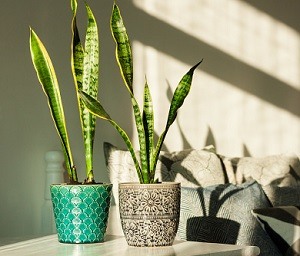
It is also called a snake plant. The plant belongs to the Asphodelaceae family and hails from Africa, India, Indonesia, and other Asian countries.
The mother-in-law’s tongue has dark green and lanced-shaped leaves. The plant forms a rosette shape when grown in a container or pot.
Snake plants come in several varieties with dark stripes and borders on the leaves. The foliages can grow up to 4 feet (20-inches).
| Origin | Africa, India, Indonesia |
| Appearance | Dark green lance-shaped leaves |
| Leaf Margin | Smooth margins |
| Flowers Color | No flowers |
| Maximum Height | 1-3ft |
Maguey
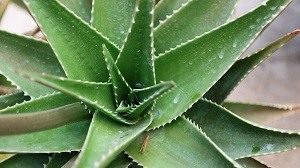
It is a succulent plant that looks like aloe with spikes. It has several medicinal properties and is native to Mexico. The anti-inflammatory properties help heal digestive problems and wounds.
Maguey is a member of the lily family and grows in arid or semi-arid areas. The thick and fleshy leaves allow the succulents to tolerate drought. It can reach 6ft tall and produce green or yellow flowers.
| Origin | Mexico |
| Appearance | Spiky succulent |
| Leaf Margin | Serrated with sharp thorns |
| Flowers Color | Green to yellow bloom |
| Maximum Height | 6ft |
Pineapple Plant
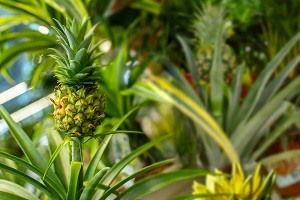
The pineapple plant is a type of cactus that looks like aloe vera. The plant has medicinal properties since it can treat diabetes, stomach problems, and constipation.
The pineapple fruits are delicious and have some health benefits. It is an excellent source of vitamins and minerals.
The pineapple leaves resemble those of aloe vera. They form a rosette with sharp spines along the edges to protect the plant and fruit.
The long oval-shaped leaves have pointed ends with spiky edges. You cannot handle these plants without protection gears.
| Origin | Brazilian rainforest |
| Appearance | Rosette-shape and looks like cactus |
| Leaf Margin | Have spines along the edges |
| Flowers Color | White-yellow |
| Maximum Height | 3-4ft |
My Final Thoughts
Many plants look like aloe vera and make them an excellent alternative for indoor or outdoor decorations. My favorite plant that looks like aloe vera without spikes is the Haworthia species.
If you love to keep succulents on your office desk, avoid poisonous plants that look like aloe vera. Besides that, avoid large plants that look like aloe vera due to the limited office desk space.
People Who Read This Also Read: